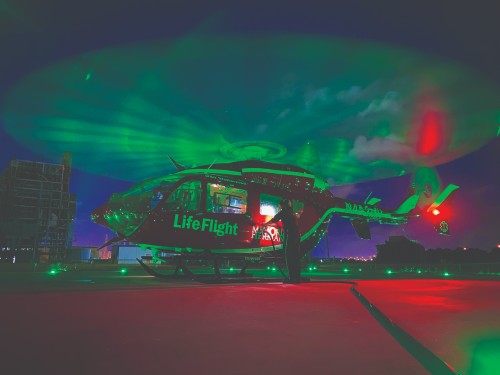 As the novel coronavirus began to spread across Houston, it became clear that Memorial Hermann Life Flight® would eventually be called upon to transport COVID-19 patients. One of the nation’s pioneers in air-ambulance transport, Life Flight would need to devise a plan on how to safeguard both patients and crewmembers aboard the aircraft. Tom Flanagan, a long-time Life Flight crewmember and now the executive director of the program, helped assemble a team of key leaders to create a plan that would involve a new robot crewmember.
As the novel coronavirus began to spread across Houston, it became clear that Memorial Hermann Life Flight® would eventually be called upon to transport COVID-19 patients. One of the nation’s pioneers in air-ambulance transport, Life Flight would need to devise a plan on how to safeguard both patients and crewmembers aboard the aircraft. Tom Flanagan, a long-time Life Flight crewmember and now the executive director of the program, helped assemble a team of key leaders to create a plan that would involve a new robot crewmember.
It only took 48 hours for the team, made up of Life Flight Medical Director Dr. Lesley Osborn, UTHealth Epidemiologist Dr. Luis Ostrosky, Tom Flanagan and the hospital’s Emergency Management team member, Brandy Ferguson, to develop a working plan.
In their plan, Life Flight would dedicate one helicopter out of its six-chopper fleet to the care of coronavirus patients, and sanitize the aircraft with help from an Ultraviolet-light sanitation robot.
Although ultraviolet technology is relatively new in health care settings, Memorial Hermann-Texas Medical Center was already using similar cleaning robots to disinfect operating rooms before and after surgeries. Flanagan reached out Sky Tron, the manufacturer and vendor of the robots, and learned this type of technology would help keep the aircraft and everybody onboard safe during the pandemic. With this information, the program purchased two cleaning robots.
The robots weigh about 40 pounds each, and require the help of two crewmembers to lift the machines on and off the aircraft. The robots are controlled outside the aircraft with a Wi-Fi remote that signals the crewmembers when the cleaning process is complete. Once activated, the robots emit a blue light that scans the entire aircraft for any signs of viruses. The light blinks on and off, using radioactive UV rays to clean all traces of bacteria in its path. The cleaning process takes about 20 to 30 minutes in total.
To keep the crewmembers safe and the aircraft clean, only main essentials would be onboard the helicopter. Additionally, crewmembers would be required to wear proper PPE: scrubs, plastic gloves and N95 masks. After each flight, these crewmembers would be required to change and wash up in the decontamination room.
One thing is clear: the old way of doing things is gone, regardless of the virus. Even on non-COVID-19 calls, all patients transported by Life Flight will have their temperature taken and be masked for protection. By listening and watching what is happening around the world, the Life Flight program will continue to strive to stay at the forefront of emergency medical services) as well as for other hospitals needing air-medical transport for their patients.
Memorial Hermann Life Flight is the only not-for-profit hospital-based air ambulance service serving Houston and surrounding communities 24-hours a day, 365 days a year (weather permitting) within a 150-mile radius of the Texas Medical Center.
Red Duke Trauma Institute Newsletter Sign Up
Use the form below to sign up to receive our Red Duke Trauma Institute Newsletter with helpful articles about our services, case studies relevant to clinical protocols practiced on a daily basis, information about available educational opportunities and many other updates for health care professionals and first responders.
You!
Thank you for subscribing to the Trauma eNewsletter.

Donate to Red Duke Trauma Institute
Please consider making a donation to the Red Duke Trauma Institute at Memorial Hermann-Texas Medical Center. No matter which area of the mission you support, your gift will make a lasting impact on patients and their families.
Donate Now